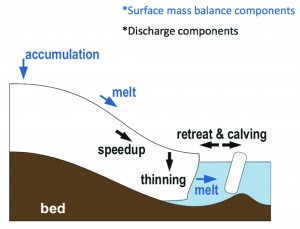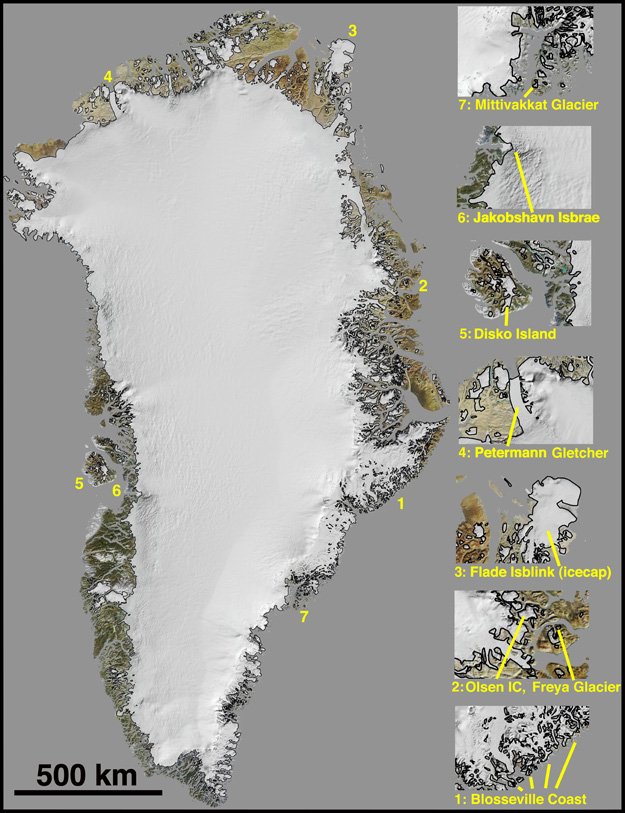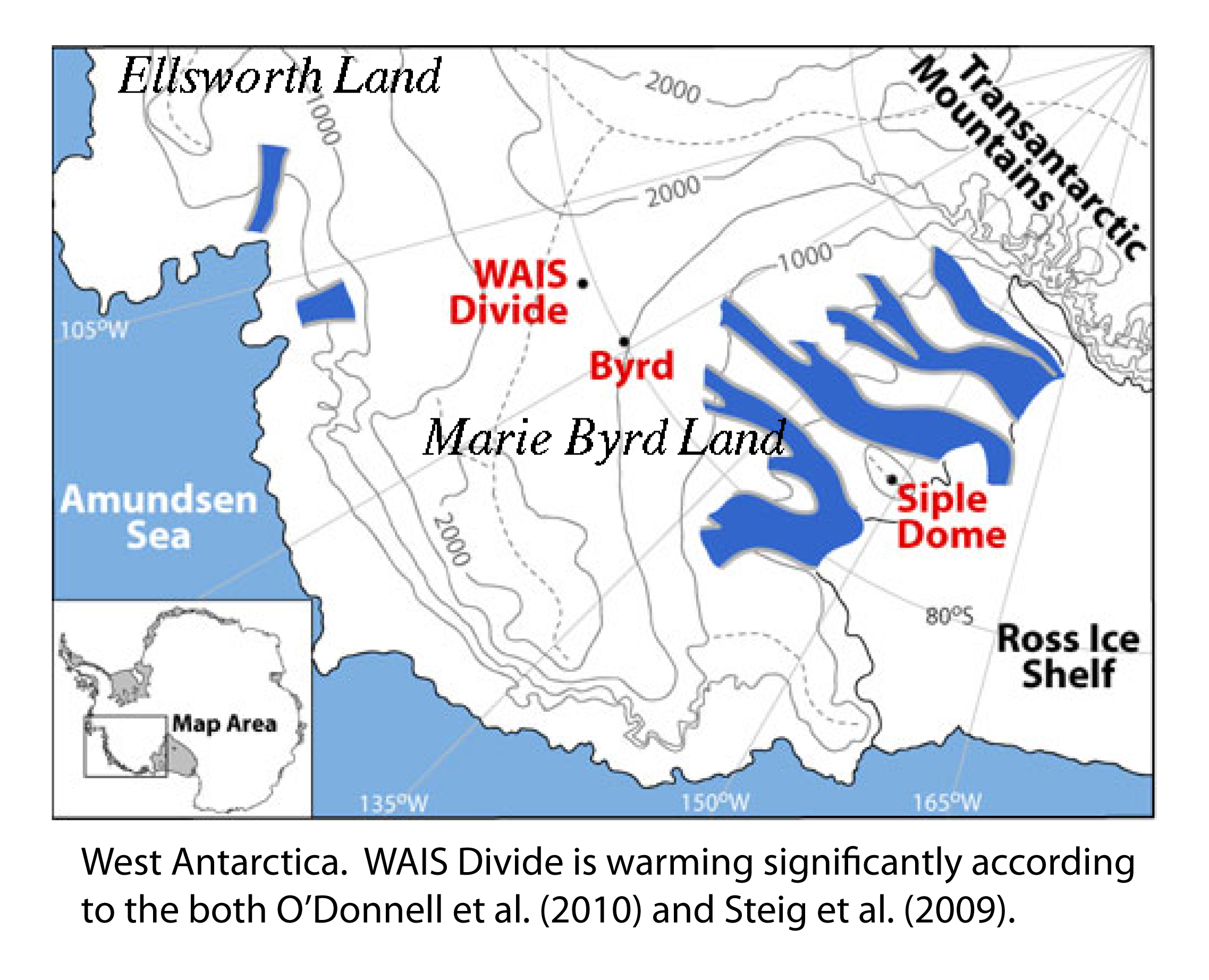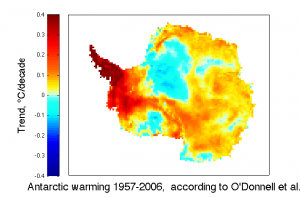In the Northern Hemisphere, the late 20th / early 21st century has been the hottest time period in the last 400 years at very high confidence, and likely in the last 1000 – 2000 years (or more). It has been unclear whether this is also true in the Southern Hemisphere. Three studies out this week shed considerable new light on this question. This post provides just brief summaries; we’ll have more to say about these studies in the coming weeks. [Read more…] about Fresh hockey sticks from the Southern Hemisphere
Greenland Glaciers — not so fast!
There have been several recent papers on ice sheets and sea level that have gotten a bit of press of the journalistic whiplash variety (“The ice is melting faster than we thought!” “No, its not!”). As usual the papers themselves are much better than the press about them, and the results less confusing. They add rich detail to our understanding of the ice sheets; they do not change estimates of the magnitude of future sea level rise.
One of these recent papers, by Hellmer et al., discusses possible mechanisms by which loss of ice from the great ice sheets may occur in the future. Hellmer et al.’s results suggest that retreat of the Ronne-Filchner ice shelf in the Weddell Sea (Antarctica) — an area that until recently has not received all that much attention from glaciologists — might correspond to an additional rise in global sea level of about 40 cm. That’s a lot, and it’s in addition to, the “worst case scenarios” often referred to — notably, that of Pfeffer et al., (2008), who did not consider the Ronne-Filchner. However, it’s also entirely model based (as such projections must be) and doesn’t really provide any information on likelihood — just on mechanisms.
 Among the most important recent papers, in our view, is the one by Moon et al. in Science earlier this May (2012). The paper, with co-authors Ian Joughin (who won the Agassiz Medal at EGU this year), Ben Smith, and Ian Howat, provides a wonderful new set of data on Greenland’s glaciers. This is the first paper to provide data on *all* the outlet glaciers that drain the Greenland ice sheet into the sea.
Among the most important recent papers, in our view, is the one by Moon et al. in Science earlier this May (2012). The paper, with co-authors Ian Joughin (who won the Agassiz Medal at EGU this year), Ben Smith, and Ian Howat, provides a wonderful new set of data on Greenland’s glaciers. This is the first paper to provide data on *all* the outlet glaciers that drain the Greenland ice sheet into the sea.
The bottom line is that Greenland’s glaciers are still speeding up. But the results put speculation of monotonic or exponential increases in Greenland’s ice discharge to rest, an idea that some had raised after a doubling over a few years was reported in 2004 for Jakobshavn Isbræ (Greenland’s largest outlet glacier). Let it not be said that journals such as Science and Nature are only willing to publish papers that find that thing are “worse than we thought”! But neither does this new work contradict any of the previous estimates of future sea level rise, such as that of Vermeer and Rahmstorf. The reality is that the record is very short (just 10 years) and shows a complex time-dependent glacier response, from which one cannot deduce how the ice sheet will react in the long run to a major climatic warming, say over the next 50 or 100 years.
These new data provide an important baseline and they will remain important for many years to come. We asked Moon and Joughin to write a summary of their paper for us, which is reproduced below.
Guest Post by By Twila Moon and Ian Joughin, University of Washington
The sheer scale of the Greenland and Antarctic ice sheets pose significant difficulties for collecting data on the ground. Fortunately, satellites have brought in a new era of ice sheet research, allowing us to begin answering basic questions – how fast does the ice move? how quickly is it changing? where and how much melting and thinning is occurring? – on a comprehensive spatial scale. Our recent paper, “21st-century evolution of Greenland outlet glacier velocities”, published May 4th in Science, presented observations of velocity on all Greenland outlet glaciers – more than 200 glaciers – wider than 1.5km [Moon et al., 2012]. There are two primary conclusions in our study:
1) Glaciers in the northwest and southeast regions of the Greenland ice sheet, where ~80% of discharge occurs, sped up by ~30% from 2000 to 2010 (34% for the southeast, 28% for the northwest).
2) On a local scale, there is notable variability in glacier speeds, with even neighboring glaciers exhibiting different annual velocity patterns.
There are a few points on our research that may be easy to misinterpret, so we’re taking this opportunity to provide some additional details and explanation.
Melt and Velocity
The Greenland ice sheet changes mass through two primary methods: 1) loss or gain of ice through melt or precipitation (surface mass balance) and 2) loss of ice through calving of icebergs (discharge) (Figure 1) [van den Broeke et al., 2009]. It is not uncommon for people to confuse discharge and melting. Our measurements from Greenland, which are often referred to in the context of “melt”, are actually observations of velocity, and thus relate to discharge, not in situ melting.

Figure 1. Components of surface mass balance and discharge. Most components can change in both negative (e.g., thinning) and positive directions (e.g., thickening).
When glaciologists refer to “increased melt” they are usually referring to melt that occurs on the ice sheet’s top surface (i.e., surface mass balance). Surface melt largely is confined to the lower-elevation edge of the ice sheet, where air temperature and solar radiation can melt up to several meters of ice each year during summer. Melt extent depends on air temperatures which tend to be greatest at more southerly latitudes. Meltwater pools in lakes and crevasses, often finding a path to drain through and under the ice sheet to the ocean. Glaciologists and oceanographers have found evidence for notable melt where the ice contacts ocean water [Straneo et al., 2010]. So, when you hear about ice sheet “melt”, think surface lakes and streams and melting at the ends of the glaciers where they meet the ocean.
So, why focus on velocity instead of melt? Velocity is more closely related to the discharge of ice to the ocean in the process of which icebergs break off, which float away to melt somewhere else potentially far removed from the ice sheet. You can picture outlet glaciers as large conveyor belts of ice, moving ice from the interior of the ice sheet out to the ocean. Our velocity measurements help indicate how quickly these conveyor belts are moving ice toward the ocean. Given climate change projections of continued warming for the Greenland ice sheet [IPCC, 2007], it’s important to understand at what speeds Greenland glaciers flow and how they change. On the whole, the measurements thus far indicate overall speedup. It turns out that on any individual glacier, however, the flow may undergo large changes on an annual basis, including both speeding up and slowing down. With these detailed measurements of glacier velocity, we can continue to work toward a better understanding of what primary factors control glacier velocity. Answers to this latter question will ultimately help us predict the ice sheet’s future behavior in a changing climate.
Sea Level Rise
Translating velocity change into changes in sea level rise is not a straightforward task. Sea level change reflects the total mass of ice lost (or gained) from the ice sheet. Determining this quantity requires measurements of velocity, thickness, width, advance/retreat (i.e., terminus position), and density – or, in some cases, an entirely different approach, such as measuring gravity changes.
Our study does not include many of the measurements that are a part of determining total mass balance, and thus total sea level rise. In another paper that we highlight in our study, Pfeffer et al. [2008] used a specifically prescribed velocity scaling to examine potential worst-case values for sea level rise. The Pfeffer et al. paper did not produce “projections” of sea level rise so much as a look at the limits that ice sheet dynamics might place on sea level rise. It is reasonable to comment on how our observations compare to the prescribed velocity values that Pfeffer et al. used. They lay out two scenarios for Greenland dynamics. The first scenario was a thought experiment to consider sea level rise by 2100 if all glaciers double their speed between 2000 and 2010, which is plausible given the observed doubling of speed by some glacier. The second experiment laid out a worst-case scenario in which all glacier speeds increased by an order of magnitude from 2000 to 2010, based on the assumption that greater than tenfold increases were implausible. The first scenario results in 9.3 cm sea level rise from Greenland dynamics (this does not include surface mass balance) by 2100 and the second scenario produces 46.7 cm sea level rise by 2100. The observational data now in hand for 2000-2010 show speedup during this period was ~30% for fast-flowing glaciers. While velocities did not double during the decade, a continued speedup might push average velocities over the doubling mark well before 2100, suggesting that the lower number for sea level rise from Greenland dynamics is well within reason. Our results also show wide variability and individual glaciers with marked speedup and slowdown. In our survey of more than 200 glaciers, some glaciers do double in speed but they do not approach a tenfold increase. Considering these results, our data suggest that sea level rise by 2100 from Greenland dynamics is likely to remain below the worst-case laid out by Pfeffer et al.
By adding our observational data to the theoretical results laid out by Pfeffer et al., we are ignoring uncertainties of the other assumptions of their experiment, but refining their velocity estimates. The result is not a new estimate of sea level rise but, rather, an improved detail for increasing accuracy. Indeed, a primary value of our study is not in providing an estimate of sea level rise, but in offering the sort of spatial and temporal details that will be needed to improve others’ modeling and statistical extrapolation studies. With just ten years of observations, our work is the tip of the iceberg for developing an understanding of long-term ice sheet behavior. Fortunately, our study provides a wide range of spatial and temporal coverage that is important for continued efforts aimed at understanding the processes controlling fast glacier flow. The record is still relatively short, however, so continued observation to extend the record is of critical importance.
In the same Science issue as our study, two perspective pieces comment on the challenges of ice sheet modeling [Alley and Joughin, 2012] and improving predictions of regional sea level rise [Willis and Church, 2012]. Clearly, all three of the papers are connected, as much as in pointing out where we need to learn more as in indicating where we have already made important strides.
Alley, R. B., and I. Joughin (2012), Modeling Ice-Sheet Flow, Science, 336(6081), 551-552.
IPCC (2007), Climate Change 2007: The Physical Science Basis. Contribution of Working Group I to the Fourth Assessment Report of the Intergovernmental Panel on Climate Change, S. Solomon et al., Eds., Cambridge University Press, ppp 996.
Moon, T., I. Joughin, B. Smith, and I. Howat (2012), 21st-Century Evolution of Greenland Outlet Glacier Velocities, Science, 336(6081), 576-578.
Pfeffer, W. T., J. T. Harper, and S. O’Neel (2008), Kinematic constraints on glacier contributions to 21st-century sea-level rise, Science, 321(000258914300046), 1340-1343.
Straneo, F., G. S. Hamilton, D. A. Sutherland, L. A. Stearns, F. Davidson, M. O. Hammill, G. B. Stenson, and A. Rosing-Asvid (2010), Rapid circulation of warm subtropical waters in a major glacial fjord in East Greenland, Nature Geoscience, 3(3), 1-5.
van den Broeke, M., J. Bamber, J. Ettema, E. Rignot, E. Schrama, W. Van De Berg, E. Van Meijgaard, I. Velicogna, and B. Wouters (2009), Partitioning Recent Greenland Mass Loss, Science, 326(5955), 984-986.
Willis, J. K., and J. A. Church (2012), Regional Sea-Level Projection, Science, 336(6081), 550-551.
Copernicus and Arrhenius: Physics Then and Physics Today
There was a really interesting article in Physics Today this past October on the parallels between the slow acceptance of the idea of anthropogenic climate change and of the idea that the earth circles the sun.
[Read more…] about Copernicus and Arrhenius: Physics Then and Physics Today
Times Atlas map of Greenland to be corrected
We were pleased to hear from the University of Arizona’s Jeff Kargel that the Times Atlas folks are now updating their atlas of Greenland. As we reported earlier, the first edition was completely in error, and led to some rather bizarre claims about the amount of ice loss in Greenland. Kargel reports that HarperCollins (publisher of the Times Atlas) has now fully retracted their error and has produced a new map of Greenland that will be made available as a large-format, 2-side map insert for the Atlas and will also be available free online. Meanwhile, Kargel and colleagues have produced their own updated small-scale map and have written a paper that includes both their new map and a description of the incident that led up to it. Kargel was instrumental in pushing the cryosphere community to send a strong message to the publishers that they needed to correct their mistake. (A pre-print of the paper, currently under review and under public discussion on Cryolist, is available here.)
 Figure 1 in Kargel et al. (2011) generated by a collaboration of the Geological Survey of Denmark and Greenland (GEUS) and the Programme for Monitoring of the Greenland Ice Sheet (PROMICE) with the Polar Geospatial Center Department of Geology and Geophysics, University of Minnesota. Contact: Michele Citterio (GEUS) for questions about the glacier outlines or Paul Morin (UMinn.) for questions about the MODIS base image mosaic.
Figure 1 in Kargel et al. (2011) generated by a collaboration of the Geological Survey of Denmark and Greenland (GEUS) and the Programme for Monitoring of the Greenland Ice Sheet (PROMICE) with the Polar Geospatial Center Department of Geology and Geophysics, University of Minnesota. Contact: Michele Citterio (GEUS) for questions about the glacier outlines or Paul Morin (UMinn.) for questions about the MODIS base image mosaic.
HarperCollins is to be commended for listening to the scientific community and producing a corrected map. Unfortunately, and despite recent events demonstrating that popular allegations against climate scientists are all wrong, HarperCollins still says on their web site that it’s all the scientists’ fault for not being clear (“The one thing that is very apparent is that there is no clarity in the scientific and cartographic community on this issue”,they write). Hmm. Our own view is that anyone flying over Greenland en route to Europe from North America would instantly have recognized a problem with the Times Atlas (assuming they knew their location of course). As Kargel and colleagues write in their paper:
“Distinguishing manifest, ignorable nonsense from falsehoods that might take root in the public mind is difficult, but the magnitude of and apparent authority behind this particular mistake seemed to warrant a rapid and firm response. The eventually constructive reaction of HarperCollins, which not only withdrew its mistaken claim but also produced a new map to be included in the Times Atlas as an insert, shows the value of such a response. No less than grotesque trivialization, grotesque exaggeration of the pace or consequences of climate change needs to be countered energetically.”
Nevertheless, they caution that “scientists cannot possibly challenge all of the innumerable misunderstandings and misrepresentations of their work in public discourse.”
Well said. Of course, many scientists can do more, and we encourage all of our colleagues to speak publically about their research and, as the international glaciological research community did in this case, to try to correct misconceptions. At the same time, hopefully, HarperCollins will catch on and recognize that being scientifically literate is not just scientists’ responsibility, but is everyone’s responsibility.
Berkeley earthquake called off
Anybody expecting earthshaking news from Berkeley, now that the Berkeley Earth Surface Temperature group being led by Richard Muller has released its results, had to be content with a barely perceptible quiver. As far as the basic science goes, the results could not have been less surprising if the press release had said “Man Finds Sun Rises At Dawn.” This must have been something of a disappointment for anyone hoping for something else.
O’Donnellgate
or…Some thoughts on Personal Responsibility and the Peer Review Process
Eric Steig
Ryan O’Donnell made a series of serious of allegations against me at ClimateAudit, in the context of our friendly dispute about whether his new paper in the Journal of Climate supports or ‘refutes’ my own results, published in Nature.
To his credit, Ryan has offered to retract these allegations, now that he is a little better acquainted with the facts. However, it is still important, I think, to set the record straight from my point of view. There were such a great number of claims about my “dishonesty,” “duplicity” and [implied] stupidity, all of which are untrue, that it really isn’t worth trying to respond in any detail. Just responding to the main two ought to suffice to make the point. [Read more…] about O’Donnellgate
The Starship vs. Spaceship Earth
Eric Steig & Ray Pierrehumbert
 One of my (Eric’s) favorite old books is The Starship and the Canoe by Kenneth Brower It’s a 1970s book about a father (Freeman Dyson, theoretical physicist living in Princeton) and son (George Dyson, hippy kayaker living 90 ft up in a fir tree in British Columbia) that couldn’t be more different, yet are strikingly similar in their originality and brilliance. I started out my career heading into astrophysics, and I’m also an avid sea kayaker and I grew up with the B.C. rainforest out my back door. So I think I have a sense of what drives these guys. Yet I’ve never understood how Freeman Dyson became such a climate contrarian and advocate for off-the-wall biogeoengineering solutions like carbon-eating trees, something we’ve written about before.
One of my (Eric’s) favorite old books is The Starship and the Canoe by Kenneth Brower It’s a 1970s book about a father (Freeman Dyson, theoretical physicist living in Princeton) and son (George Dyson, hippy kayaker living 90 ft up in a fir tree in British Columbia) that couldn’t be more different, yet are strikingly similar in their originality and brilliance. I started out my career heading into astrophysics, and I’m also an avid sea kayaker and I grew up with the B.C. rainforest out my back door. So I think I have a sense of what drives these guys. Yet I’ve never understood how Freeman Dyson became such a climate contrarian and advocate for off-the-wall biogeoengineering solutions like carbon-eating trees, something we’ve written about before.
It turns out that Brower has wondered the same thing, and in a recent article in The Atlantic, he speculates on the answer. “How could someone as smart as Freeman Dyson,” writes Brower, “be so wrong about climate change and other environmental concerns..?”
[Read more…] about The Starship vs. Spaceship Earth
West Antarctica: still warming
The temperature reconstruction of O’Donnell et al. (2010) confirms that West Antarctica is warming — but underestimates the rate
Eric Steig
At the end of my post last month on the history of Antarctic science I noted that I had an initial, generally favorable opinion of the paper by O’Donnell et al. in the Journal of Climate. O’Donnell et al. is the peer-reviewed outcome of a series of blog posts started two years ago, mostly aimed at criticizing the 2009 paper in Nature, of which I was the lead author. As one would expect of a peer-reviewed paper, those obviously unsupportable claims found in the original blog posts are absent, and in my view O’Donnell et al. is a perfectly acceptable addition to the literature. O’Donnell et al. suggest several improvements to the methodology we used, most of which I agree with in principle. Unfortunately, their actual implementation by O’Donnell et al. leaves something to be desired, and yield a result that is in disagreement with independent evidence for the magnitude of warming, at least in West Antarctica.
 In this post, I’ll summarize the key methodological changes suggested by O’Donnell et al., discuss how their results compare with our results, and the implications for our understanding of recent Antarctic climate change. I’ll then try to make sense of how O’Donnell et al. have apparently wound up with an erroneous result.
In this post, I’ll summarize the key methodological changes suggested by O’Donnell et al., discuss how their results compare with our results, and the implications for our understanding of recent Antarctic climate change. I’ll then try to make sense of how O’Donnell et al. have apparently wound up with an erroneous result.
[Read more…] about West Antarctica: still warming
A brief history of knowledge about Antarctic temperatures
Sources in italics.
Scott: It’s cold here.
The media: Scott is a hero!
Scott: It’s really really cold here.
The media: Scott is a hero!
Amundsen: It’s not that cold.
The media: Scott is a hero. Oh, and Amundsen.
Public: Shackleton is a hero, but please shut up, there’s a war on.
Mid 20th Century:
Geophizzicists: Let’s find out just how cold it is.
Media: Scott is a hero!
Public: yawn…
Late 20th Century:
Scientists: It’s colder in some place than others.
Media: Antarctica is cooling.
Scientists: It’s cooling at the South Pole, but warming very fast on the Peninsula.
Media: Antarctica is cooling, but warming faster than anywhere else on earth.
Public: Huh…?
2000
Thompson and Solomon: Most of Antarctica is cooling in summer, but it is warming on the Peninsula. We think it has to do with the ozone hole.
Media: Because of ozone, Antarctica is warming faster than anywhere else on earth and we are all going to die.
Public: Huh…?
Early 21st Century:
2006
Scientists: The troposphere over Antarctica is warming significantly in winter.
Media: Even though that paper was published in Science, our readers don’t know what the troposphere is. Neither do we. Next?
2007
Scientists: The troposphere over Antarctica is warming significantly in winter and spring, especially over West Antarctica.
Media: That paper wasn’t published in Nature, so we’re not very interested.
2009
Scientists: Antarctica is cooling in fall — not summer — in some places, but warming, especially in winter and spring, especially in West Antarctica.
Media: Antarctica stops cooling! Conservative or liberal, we are ALL going to die.
Steve McIntyre: The “team” made up the data again. I don’t know what Antarctica is doing, but I think it is probably cooling.
Media: Antarctica starts cooling again, global warming is a fraud.
2010
Ryan O’Donnell: Our paper in the Journal of Climate shows a somewhat better way to look at the same data. Antarctica is warming a bit more in summer, and a bit less in winter in the Ross Sea region. In fall it is cooling a bit more too, and so the overall trends are smaller. Still, West Antarctica is definitely warming significantly, as Steig et al. found. That’s interesting.
Eric Steig: Nice paper Ryan. Thanks for sending along a pre-print.
Steve McIntyre: Hey, we got published in the Journal of Climate! Another paper showing that the “team” made up the data again! (Sotto voce): Ryan says it it is warming a bit more in summer, and a bit less in winter in the Ross Sea region. In fall it is cooling a bit more. Otherwise we get the same results, though the magnitude of the trends is smaller. But West Antarctica is still warming significantly. But I really don’t care. The peer review process is broken, which is why.. umm…our paper was published in the leading climate journal.
Liberal Media: That paper wasn’t published in Nature, so we’re not very interested.
Conservative Media: Antarctica is cooling. Global warming is a fraud.
Public: zzzZZZzzz
————-
P.S. For those actually interested, yes, I’ll have more to say about O’Donnell et al., but overall, I like it.–eric
Climate code archiving: an open and shut case?
Gavin Schmidt and Eric Steig
The last couple of weeks saw a number of interesting articles about archiving code – particularly for climate science applications. The Zeeya Merali news piece in Nature set the stage, and the commentary from Nick Barnes (of ClearClimateCode fame), proposed an ‘everything and the kitchen sink’ approach. Responses from Anthony Vejes and Stoat also made useful points concerning the need for better documentation and proper archiving. However, while everyone is in favor of openness, transparency, motherhood and apple pie, there are some serious issues that need consideration before the open code revolution is going to really get going.
[Read more…] about Climate code archiving: an open and shut case?
